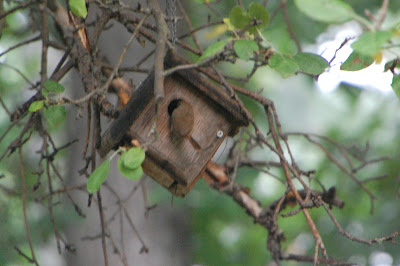About 10 days from the end of April, I read several reports of house wrens returning to areas of New Jersey close, as the wren flies, to where I live. I had been avidly awaiting this news for weeks. Two days later, with my husband steadying the ladder, I hung the nest box in the dogwood tree, which had beat the odds and come back to flowering life after I had the dead wood removed.

The nest box in the dogwood
(Margo D. Beller)
Hanging a nest is an annual ritual. It started when a friend gave me a small, decorative bird house that I hung in one of the apple trees. It soon drew a house wren, perhaps the only bird that could have fit through the small opening. I hung that bird house out every year until it fell apart. I've used a sturdier (and slightly larger) nest box ever since, first hung in the one apple tree I didn't take down and then in the dogwood so I could see it more easily from my seat on the enclosed porch.
I hung the box and waited. And waited.
Seemingly the day after hanging it the weather turned winter-like. Northbound migration was altered as birds avoided the north winds of the northeast and traveled up through the midwest. Seedllings were left on window sills because it was too cold to plant them. The down quilt stayed on the bed.
Finally, at the very end of April the winds turned around, the temperatures warmed dramatically and the migration floodgates were opened in my region. One early walk I heard house wrens calling. On May 1 I heard the same call from my yard. A bird checked out the nest box, my feeders, the immediate area. Would he find a mate and would she want to nest in my box?
Yes and yes, a day later. Hooray.
Thanks to having more time to spend on the porch, I could see details I'd missed in previous years.
 |
| House wren from a previous year. I haven't tried to take a picture of this year's pair yet. (Margo D. Beller) |
On May 3 the pair took turns bringing large sticks to the box to create the nest where they will likely raise two to three chicks. (The Cornell Ornithology Lab people say it could be as many as 10, but that would be too many for this box.) Each bird came back with sticks too large to fit in the doorway as held in its beak. Each bird had to re-learn that if he or she turned his or her head, the sticks could be put inside. Or, if the stick was thin enough, the bird could just ram it through the hole. Both birds had to do this many times. It became comical to watch.
But they kept at it. The next day, May 4, it was only the female working on the nest, bringing in smaller sticks to put on the finishing touches. As far as I could see the male did not go into the box. I could tell which bird was which because he sang from another branch. She did not.
On May 5 it rained. There was some movement in and out of the box by the female and singing at dawn by the male. However, I was inside for most of the day and so do not know when or where any mating took place. Because that is the next step - the female has to lay eggs and she has to sit on them on the nest they made.
Once again I regretted not buying one of those minuscule cameras I could have put inside the box and get an entirely different view. If they do what I've seen other wrens do over the years, the female will be in the box much of the time and the male will be singing nearby. If a larger bird it considers a threat - such as a house sparrow interested in taking the box for itself (it can't fit through the opening but that doesn't mean it won't try and destroy the eggs) - the wren will drive it off, if I don't first. When the female needs to get a meal he will stay close to the box until she returns.
 |
| Feeding the young from the outside. (Margo D. Beller - From 2020 when I hung the box in the apple tree.) |
Once the chicks hatch their mother won't leave them unless she has to eat. At that point the male will sit close by. Then she'll return to feed them and keep them warm. When they get bigger both parents will only go into the nest to feed them. As the young get even bigger they will get noisier and will be fed by both parents from outside the box.
The whole incubation/nesting process will only last a few weeks. At some point I've yet to catch the parents will stop feeding them but will call the young from nearby - you have to leave the nest to get a meal, kids. The young will fly out and the nest stay empty. The family will hang out around the yard for a time, maybe a week or so, and then disperse.
If I am lucky, another wren - or maybe the same male - will find the box, bring a female that approves of it and they'll use the sticks I'll leave in there for their nest. At the end of the year the house wrens will head south and the box will be taken down, emptied, cleaned and stowed away until next spring.
It is an annual ritual that brings me closer to the life of a tiny, plain, brown bird that graces my yard for a few weeks.
